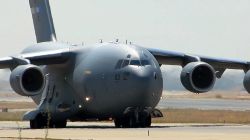Last Boeing C-17 Military Cargo Plane Goes To Qatar

The last C-17 Globemaster III, built at a Southern California Boeing plant did fly over, marking the end of an era for the california’s once-thriving aerospace industry in the USA.
The jet, which can hold more than 80 tons of cargo, will be housed in San Antonio, Texas, until it is delivered to the Qatar Emiri Air Force early next year, the company announced today.
"This is truly the end of an era. It's a sad day, but one that all of the Boeing employees and suppliers who have worked over the years building this great aircraft can be proud of," Nan Bouchard, vice president and C-17 program manager, said in a statement.
The Long Beach facility assembled more than 250 C-17s over two decades but Boeing announced two years ago that it didn't have enough foreign orders to justify keeping the plant open.
With production ending, most of the 25-acre plant will be shuttered by year's end. However, some engineering support for aircraft may continue there for a year or two.
Earlier this year, Boeing announced plans to lay off as many as several hundred workers at an El Segundo satellite factory. Some of the drop is due to the end of military programs and to purse-tightening by the Pentagon and civilian aircraft purchasers.
Last month, the Air Force chose Virginia-based Northrop Grumman Corp. to build its next-generation bomber. Much of the plane's assembly could occur in the Southern California desert community of Palmdale, home of Air Force Plant 42, a military industrial park leased to aerospace contractors where the B-1 and B-2 bombers were built.
Northrop Grumman said last year it could create 1,500 new jobs in Palmdale under the $80 billion bomber contract.
The Spaceship producers SpaceX and Virgin Galactic both have facilities in Southern California.










